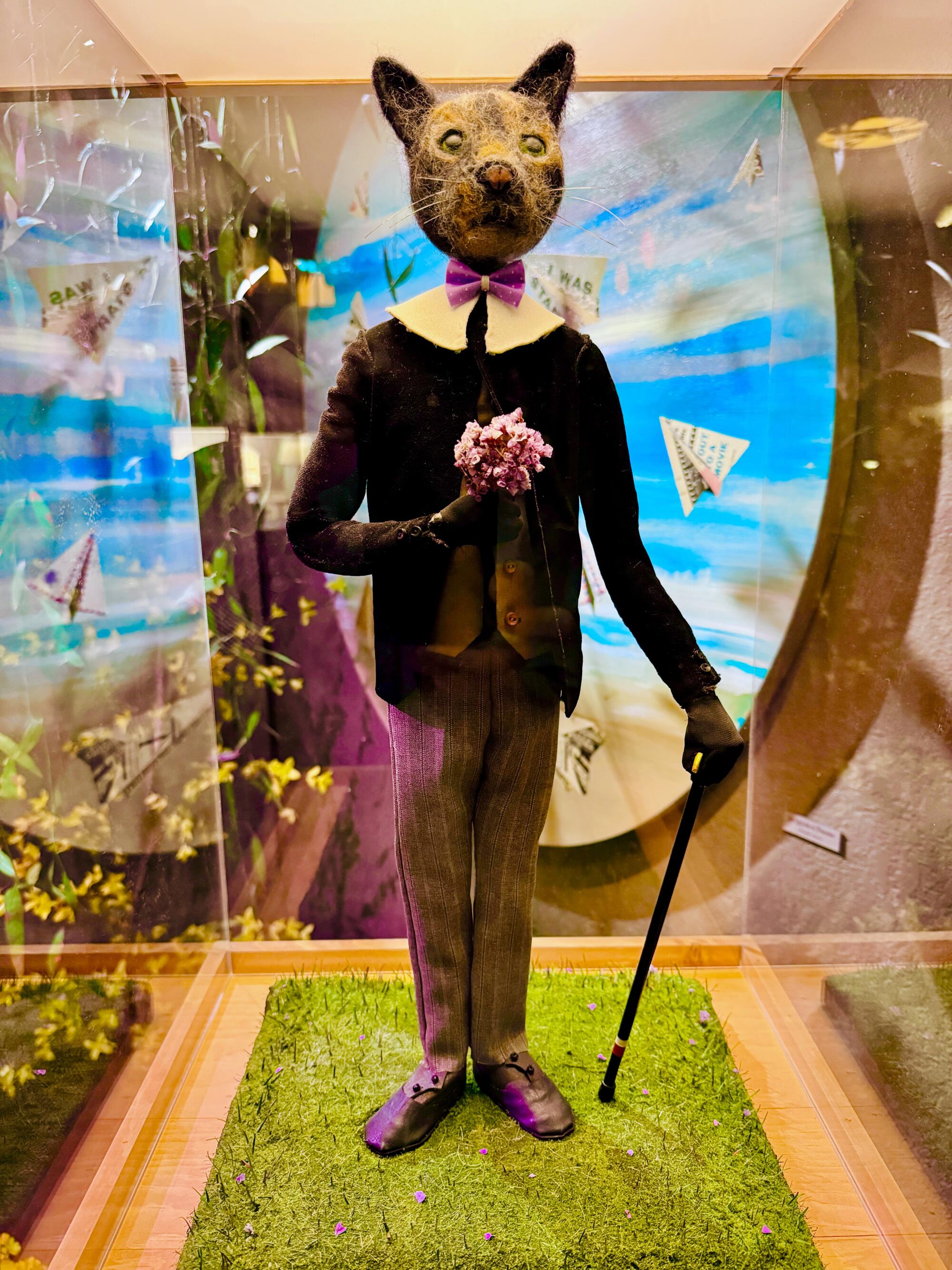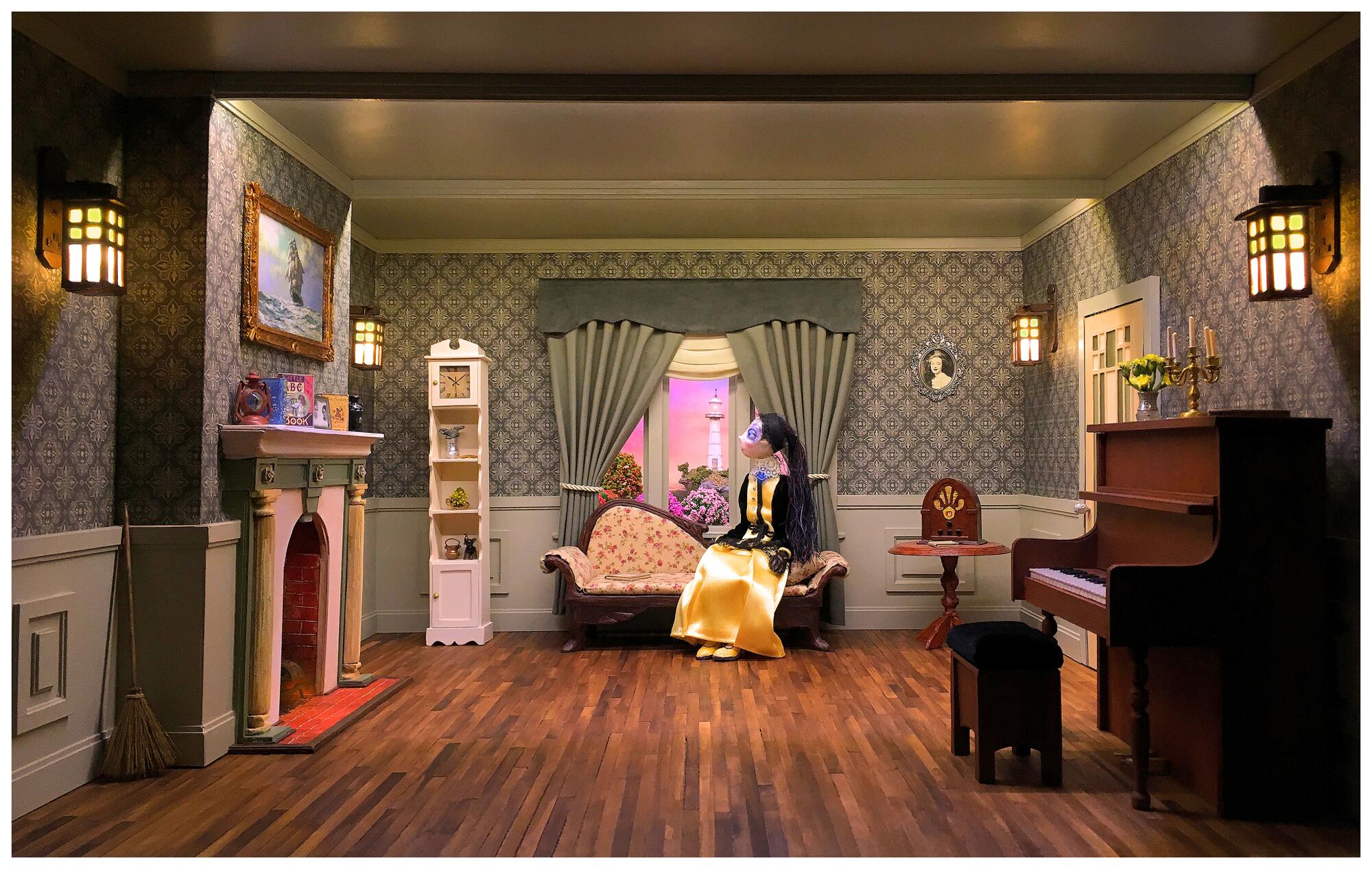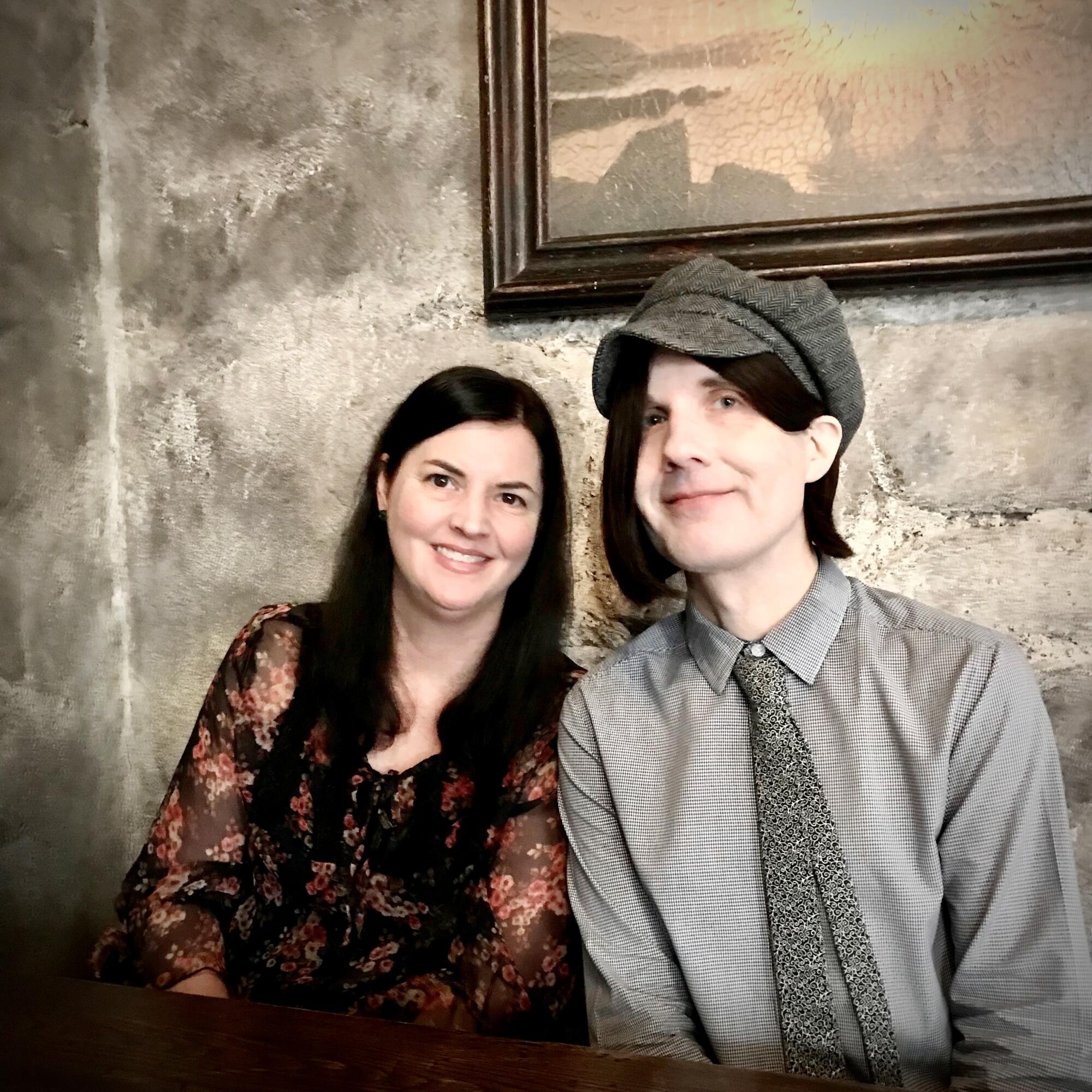With a playful spirit and a childlike sense of curiosity, it’s perhaps no surprise that the whimsically named Museum of Make Believe appealed instantly to a young audience. The Laguna Beach space, a 1,000-square-foot love letter to fairy tales, is a fantastical, mystical wonderland, where fables of lost love, ghostly pets and irresistible avarice are told via miniature installations and ornate, storybook art.
Its founders, however, had a different audience in mind.
“We built it for adults,” says Museum of Make Believe cofounder Amy Mitchell, who opened the space with her longtime partner, Geoff Mitchell, just over a year ago. “The first week we were open, we were stunned that we had kids coming — hordes of kids.”

Fantastical puppets made of ceramic and felt dot the landscape inside the Museum of Make Believe.
(The Museum of Make Believe)
Calming and handcrafted, to wander into the Museum of Make Believe feels akin to stepping into an antique playground, though its creations are modern. It’s a fantasy forest sprung to life, complete with a centerpiece tree and felt and ceramic sculptures of dapperly dressed felines and canines. Only this dreamland is dedicated to timeless tales laced with life lessons.
While designed to be family friendly, the narratives tap into the approach of fairy tales of yore — that is, they can be dark, and decidedly heartbreaking, despite a welcoming dragon with piercing emerald eyes among the first items guests encounter.
As Amy and Geoff adjusted to a younger audience, they made some small tweaks. Up went mini fences, as much of the art in the Museum of Make Believe is fragile. The majority of pieces were designed by Geoff, a fine artist who has exhibited at multiple galleries and museums, including the Muzeo Museum and Cultural Center in Anaheim. Amy estimates the couple spends about two to three hours each evening repairing paint and foam. But it’s worth it, she says.
“I don’t want to lose the charm of the handmade-ness,” Amy says.
The all-ages appeal of the museum is a testament to the everlasting approach of the couple’s narratives, which handle difficult life moments with a fanciful nature, but never hold your hand. I teared up at one story, “The Hourglass,” a tale of a decades-long love for another that went unanswered until life’s final moments.

Fairy tales at the Museum of Make Believe are told via heavily detailed dioramas.
(The Museum of Make Believe)
It’s not an entirely uncommon reaction to some of the stories within the Museum of Make Believe. There are moments, for instance, that touch on losing a pet.
“We had a lady who came in during our first few months of being open,” says Amy, whose stories tend melancholy. “She sat in the back and cried for like 15 minutes. She came by herself, and said, ‘I wasn’t really prepared for this, but I needed it.’ She needed the atmosphere and the environment, and sometimes it’s a little cathartic.”
Cathartic, but also emblematic of a simple story done well, and a reminder that fairy tales are not just hopeful yarns of a happily ever after. They’re narratives that tap into life’s universalities and help us make sense of the world around us. And the Museum of Make Believe is partly the result of a tension in Geoff’s art — his love, for instance, of folklore and Disneyland, but a fear that giving into those tendencies will betray a desire to be a serious artist.
“I went to the Minneapolis College of Art and Design,” Geoff says. “It was very conceptual, and it was very strict. If you were going to make art that its intention was to be beautiful — that it was beauty for the sake of the beauty — you probably have a very good very reason that you’re doing that, but entertainment was frowned upon. … It took probably 15 years to decide, ‘Oh, to hell with it, I’m just going to do what I want to do.’”

Amy and Geoff Mitchell met when they were teenagers. Now in their 50s, they have started Laguna Beach’s Museum of Make Believe.
(Courtesy of Amy Mitchell)
Amy and Geoff, high school sweethearts who met in their teens in Gulfport, Miss., are today in their early 50s, and the Museum of Make Believe has become a labor of love. Run as a nonprofit, the two take no salary from the space, as each penny goes back into realizing their dreams for expansion. The pair have grand plans, hoping for a larger enchanted forest and even someday an old-fashioned soda fountain. That’s also why Amy maintains her day job, a regional director of admission for Emerson College. The two recently left their longtime apartment in Anaheim — a mile from Disneyland, Amy stresses with regret — to be closer to the museum.
Ultimately, they think of the Museum of Make Believe as something akin to an art gallery, a pocket-sized version of, say, what Meow Wolf attempts to do with its all-encompassing walk-around spaces. They’re working hard to make each square inch explorable, creating, at the time of the interview, a sandcastle to be hidden in the restroom.
Though cozy, one should expect to spend about 60 to 90 minutes inside the Museum of Make Believe. There’s a quest, with a light puzzle to solve, that encourages guests to carefully read each of the five core fairy tales and look intently into its dioramas. Each installation is filled with details — mini-vintage radios, tiny artwork on the walls and cases full of scaled-down tools of spirituality. Some of the fables, such as “The Locket,” are told in multiple parts, its story of a humble sea trader and the allure and dangers of wealth spread among multiple displays and a lighthouse.
“Fairy tales are kind of like poems,” Amy says. “Both ghost stories and fairy tales also have a moral to them. I like that idea. I like that there’s a little lesson, if you want to take it.”

A cheerful dragon greets guests inside the Museum of Make Believe.
(The Museum of Make Believe)
Geoff’s art masks any sense of time or place. There’s an obscure, borderline experimental streak to his work, one that he describes as marrying the Beatles’ take on ‘60s psychedelia with Disneyland’s vision of “Alice in Wonderland.” Animal puppets, for instance, are joyful and yet oddly formal.
“I think that there’s a nostalgia, and a sentimental-ness,” Geoff says when asked why humans are still drawn to fairy tales. “Not in a silly way. But they are ghost stories.”
They feel, he says, like part of a collective memory.
And yet at the Museum of Make Believe’s heart, there’s an underlying belief that dreams come true. I left with a tiny rock, a “tomorrow stone,” in which a scroll stated my “fondest dream, greatest desire and strongest wish” would come to pass if I held the gem once daily. I reveal to Amy and Geoff that clutching the stone is now part of my morning routine.
The Museum of Make Believe
There’s no laughter.
Amy says the “tomorrow stone” is an extension of what she called her “dream box,” which she had acquired on a trip to the Grand Canyon with her father. Each day, she made a wish that the Museum of Make Believe would become a reality, and eventually the couple received a grant that allowed them to realize their vision.
And thus, the pair behind the Museum of Make Believe leave me with a promise: “Tell us when it comes true,” Amy says.


